
Island Plant Adaptations Guide Stop 1
The Native Plant Garden includes many plants that are unique island forms. Each trail station includes a brief discussion of these plants and their adaptation to the isolated island environment.
Trail stops for this island plant adaptations guide are marked by numbered posts and decorated with a leaf shape.
A separate trail guide describing the Chumash use of many of these plants is also available at the trailhead and in the visitor center. Download a PDF of either guide at Guide to Island Plant Adaptations or Guide to Island Chumash Plant Usage
As you walk the trail remember many native plants are easily damaged. Please do not pick the flowers or touch the plants.
Introduction
The warm morning sun climbs from a low bank of fog to illuminate a brilliant field of yellow-flowered coreopsis of Anacapa Island. A cool breeze rustles the leaves of island oaks crowning a rocky hilltop on Santa Rosa. The soil surrounding their gnarled, moss-covered trunks is still damp with moisture from the nighttime fog. Gulls swoop and dive above a windswept cliff carpeted with green and yellow goldfields on Santa Barbara Island.
A fascinating variety of plants can be found in California's Channel Islands National Park. This is due in large measure to the many plant habitats that exist on the islands, each representing a distinct combination of environmental conditions affecting plant germination and growth. Some of these conditions include wind, sun, fog, seasonal rainfall, soil conditions, and the amount of sea salt in the air and soil. The distance and isolation of the islands from the mainland has allowed plants and animals to develop into unique island forms.
How Did Plants Reach the Channel Islands?
Plants originally arrived on the Channel Islands by a slow, steady process known as dispersal. The islands were never connected to the mainland; however, over millions of years, plants, seeds, and spores were carried from the mainland by ocean currents, wind, and birds. Some seeds and spores may also have been caught in the fur of animals that reached the islands. More recently, humans have been important agents of plant dispersal. During the prehistoric period, the Chumash may have introduced some plants to the islands. Beginning in the early 1800s, European grasses and other foreign plants became established on the islands, largely as a by-product of farming and ranching.
Toyon, which grows on all of the larger islands, is an excellent example of natural dispersal. During summer and fall the small flowers decorating the tips of the branches gave way to clusters of bright-red berries. These berries are an important source of winter food for California's birds. In turn, birds help propagate toyon by dispersing undigested seeds to new locations. The island scrub-jay also stores toyon seeds in winter food caches; seeds that are not consumed may germinate and become established as new plants.
Is there something we missed for this itinerary?
Itineraries across USA


















































